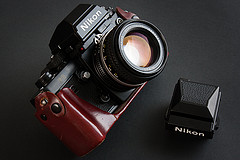Nikon F3
/Nikon F3 – Still a Viable Shooter?Launched in 1980, the Nikon F3 replaced the F2 as their top of the line professional camera body, and went from being the most controversial to one of the best selling film cameras in the history of the company.
Prior to the introduction of the F3, the Nikon pro bodies had always been fully mechanical, with no reliance on batteries except to power the meter (if you had one of
the metering heads). The F3, however, used a brand new electronically controlled horizontal-traveling titanium shutter which, in contrast to previous models, required battery power to operate.
This initially caused great consternation in the pro community, and the reluctance of many to switch to the new F3 was a real problem for Nikon. Many press photographers were unwilling to give up the reliability of their mechanical F2s for this new, untested electronic camera.
There are plenty of excellent websites that document the various features of the F3 so I won’t duplicate any of that here. What we’re interested in is basically this: is the Nikon F3 still a viable shooter today? The answer is an unreserved ‘Yes!’. A good clean body will set you back around the $200 mark, which is an amazing bargain for a camera this good, and you can use almost the entire range of Nikon manual focus lenses which can be picked up for equally good prices if you shop around a little.
The metering is very accurate, and for most situations I just leave the camera in auto mode and it very rarely gives me a bad exposure, even when shooting transparency film. The viewfinder is fantastic, one of the best I’ve used in a 35mm film camera, offering a full 100% view of the image area. If you are used to the cramped, squinty viewfinders of some consumer or ‘prosumer’ DSLRs, the F3s finder will be a revelation!
While we are on the subject, my 1986 F3 is the ‘HP’ variant, which means it has the high eye-point finder (DE3), with greater eye relief and a little less magnification. This finder is physically a little taller than the original (DE2) prism, but allows you to see the entire viewfinder image with your eye a little further from the eyepiece, which is particularly useful if you wear glasses. Even if you don’t, it’s still an excellent all-round finder and, although some users prefer the original, the F3HP variant would still be my recommendation.
A quick word about the motor drive for the F3. Known as the MD4, it’s capable of a blistering six frames per second, has power rewind and also powers the camera body when attached. What’s more, the camera and motor drive combo handles beautifully; for me it handles better than just the body alone. These can be had a very little money and make using the F3 a total blast! Oh yeah, they sound cool too!
Go get you one, and shoot some film!









